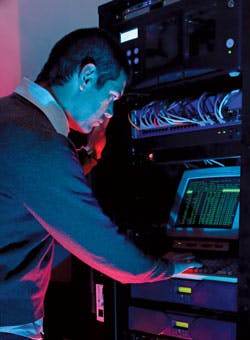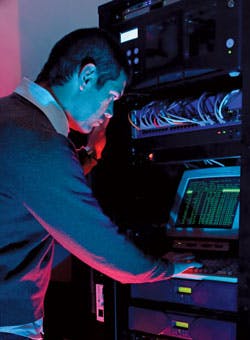Demarc extension is mostly uncharted territory
From the December, 2013 Issue of Cabling Installation & Maintenance Magazine
Extending the handoff point between public and private networks remains an area largely unstandardized yet of critical importance to user organizations.
by Patrick McLaughlin
The demarcation point is a nearly universally recognized portion of corporate networks and today, even personal residential networks. The "demarc," as it is commonly called, is most visible in residential networks in the form of the network interface device (NID), which typically is mounted onto a home and is the handoff point between the carrier/service provider's network and the customer-owned network of the homeowner. In these networks, the NID is the very point at which the service provider's network ends and the customer's network begins.
In corporate networks, the situation can be significantly murkier. The confusion is not so much a matter of the point at which the service provider's network ends; a NID does the job there as well. But from a technical standpoint, the matter can be confusing when the service provider network ends in a space physically distant from where the customer-owned network resides. Take, as a typical example, a demarc inside the basement of a multi-story building. A tenant on the fifth or sixth floor of that building must somehow connect its network--contained within a single floor--to the demarc in the basement.
In most cases, a network and associated cabling project begins with the consideration and consultation of standards related to the system or technology being deployed. In the case of extending a demarcation point into a building so it physically meets a customer-owned network, standards are scant. System specifiers, designers, installers and owners are challenged to plan and carry out such a project.
Stake in the ground
For several years Concert Technologies (www.concerttech.com) has made efforts to shed light on the challenges associated with demarc extension. Concert provides what it describes as technology rollouts nationwide. On its website, the company explains, "We provide, manage and support a worldwide field force of local onsite technicians to deploy technology infrastructure on a nationwide and global scale. This includes the dissemination and relay of technical knowledge quickly and accurately to our onsite Concert techs for the installation and service of each location."
In 2010 Concert launched a separate brand and service called Demarc Extension Nationwide (www.demarcextension.com), aimed specifically at serving the needs of network owners facing the mostly uncharted waters of extending the demarcation point. When announcing the brand's establishment, Concert stated, "There are thousands of circuits delivered weekly to organizations across the country, with each circuit requiring a demarc extension. Without the standardization of terms and installation practices, there is a high risk of negative impact to the delivery, performance and maintenance of critical telecommunications circuits and their access to the Internet and other network connections outside of a facility."
Also at that time, Concert's and Demarc Extension Nationwide's founder Dennis Mazaris said, "This has been a problem in the industry for over three decades. With a decade and a half of experience deploying technology nationwide and globally, we have taken the initiative in defining and standardizing a demarc extension--the single most critical cabling component within a facility."
On its website, Demarc Extension Nationwide provides a significant amount of information that is basic yet difficult to find in standards or other technical documents within the industry. Included among the information is a definition of the term demarc extension, as follows: "The transmission path originating from the interface of the access provider's side of a telecommunications circuit demarcation point within a premises and ending at the termination point prior to the interface of the edge customer premises equipment [CPE]. This may include in-segment equipment, media converters and patch cords as required to complete the circuit's transmission path to the edge CPE."
How we got here
Elsewhere on its site, Demarc Extension Nationwide provides a brief history of how the telecommunications industry progressed (or didn't) the definition and application of the demarc extension. It explains, "The demarc extension is governed by the authority having jurisdiction [AHJ] and Part 68 of the FCC's regulations by which cabling and edge Customer Premises Equipment [eCPE] interfaces to the local access provider network, also referred to as the Public Switched Telephone Network [PSTN]. The CPE governed includes eCPE such as routers, DSUs/CSUs [data service units/channel service units], modems and in-segment equipment such as extenders/repeaters as well as the cabling and media converters used to connect such equipment to the local access provider's network at the demarcation point."
A timeline is also provided. The following points are taken directly from demarcextension.com.
- 1984--Although Part 68 came into effect in 1975, it was not until the 1984 deregulation of the Bell companies that the establishing of a demarcation point came to be. However, like most deregulation efforts, that of the demarc extension contains several drawbacks. One of the key drawbacks is the loss of the standardization that was maintained by the local access providers prior to deregulation and the confusion over responsibility for the demarc extension.
- 1990--In August 1990 the FCC amended the definition of the demarcation point due in part to the industry confusion over the location(s) within multi-unit premises or commercial buildings. This amendment ensured that the demarcation point would be near the point where the cabling entered the customer's premises, known as the minimum point of entry (MPOE). This enacted the 12-inch rule, which states, "The demarcation point may be located within 12 inches of the point at which the wiring enters the customer premises." However, this still allowed local access providers reasonable and nondiscriminatory standard operating practices for the location of the demarcation point.
- 1997--In June 1997, the FCC clarified the wording of the 12- inch rule by adding the following: "or as near thereto as practicable." This minimized the location issues for the demarcation point within the premises.
- Today--The lack of national leadership for standardization, poor installation practices and confusion over demarc extension responsibilities in the market have negatively impacted the industry. This has subsequently caused delayed service deliveries, unwarranted revisits and excessive finger pointing for the timely connection and critical access of Internet and communication services for facilities throughout the United States.
How-to guidance
Some providers of products and technologies that can facilitate a demarcation extension also provide technical information describing how their products can be used in these environments. One such company is Omnitron Systems (www.omnitron-systems.com), a provider of technologies including NIDs, media converters and multiplexers. In one section of its website, Omnitron describes how all three product types can be used in a demarc-extension application. The specific names mentioned are Omnitron Systems products.
The setting is a multi-story building with a tenant occupying floors 10, 11 and 12. "In this riser management application," Omnitron says, "TDM and Ethernet business services are extended to tenants on the upper floors. Ethernet, T3 and multiple T1s are delivered with UTP copper cables from a service provider's Metro Ethernet or SONET network at the ground floor of the building.
"An iConverter 19-module chassis is deployed at the demarcation point on the ground floor. A GX/Tm2 NID plug-in module, a T3/E3 managed media converter and a Modular T1/E1 Multiplexer are installed in the high-density chassis. The iConverter GX/Tm2 NID module in the 19-module chassis provides copper-to-fiber conversion, and a managed fiber link to the subscriber's office on the 10th floor, where a standalone GX/Tm2 hands off the service to a 10/100/1000 copper switch. The GX/Tm2 NID modules support IEEE 802.3ah Link OAM for performance monitoring and fault management of the fiber access link. A Gm3 NID or Gm4 NID can be used to provide Carrier Ethernet service all the way to the customer handoff.
"The service provider's T3 circuit is delivered via a CSU/DSU. The T3/E3 coax is converted to fiber with the T3/E3 media converter, and the fiber is run up to the 11th floor, where a standalone T3/E3 converter provides fiber-to-copper conversion for connectivity to a subscriber's PBX.
"Four T1 circuits are also delivered via a CSU/DSU on the ground floor, with four UTP cables connecting to the iConverter Module T1/ E1 MUX."
Detailed, instructive technical documentation like this provided by Omnitron can be valuable to those responsible for accomplishing a demarcation extension, for the reasons described earlier. Demarc Extension Nationwide has authored a white paper and produced a series of videos to further its information campaign. Additionally, the firm has established a glossary of sorts (see sidebar) to establish common terminology to be used in demarcation-extension projects.
As the need for extending demarcation points continues, associated information and services are available to the industry.
Patrick McLaughlin is our chief editor.
A glossary of demarc extension terms
As part of its information campaign on the technical challenges of demarcation extension, Demarc Extension Nationwide has published on its website a list of associated terms and their definitions.
Here is a sample of the terms and definitions.
Demarc connection point: The end user connection that interfaces into the local access provider's demarcation point. May require a patch cord or crossconnect cable.
Edge termination point: The connection at the edge of the demarcation extension that interfaces with the eCPE. This does not include a patch cord, which may be required for connection with eCPE or media converters.
Segment: Defines the location(s) of media used in a demarc extension. A segment is a single continuous cable that is terminated at each end. The initial segment (segment 1) originates at the demarc connection point and the final segment ends at the edge termination point. Segments may include patch cords or crossconnects.
The web page that includes these and other definitions also includes a longer list of previously established industry terms and their definitions, taken from several industry sources.
Archived CIM Issues

